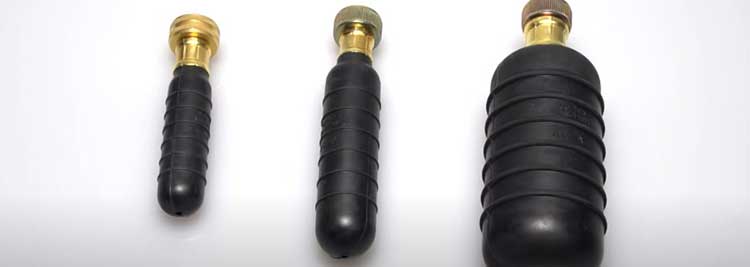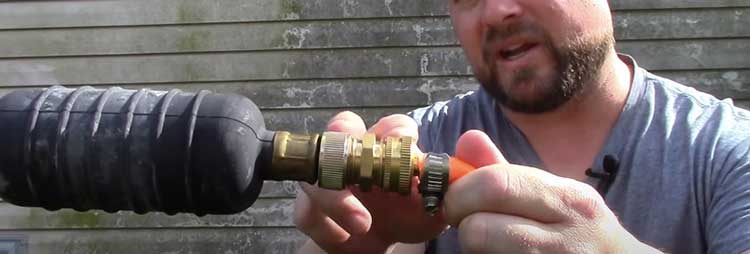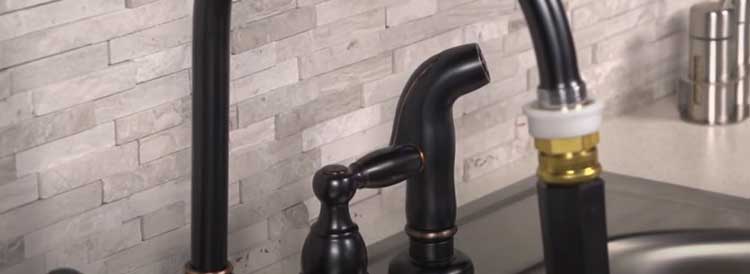Doing your plumbing can be a very rewarding task if you do it right. Clearing out heavy clogs in drains can be a very easy task with the help of a drain cleaning bladder.
Sometimes this easy task results in serious mishaps such as the bladder getting stuck inside the pipe.
So here is what you need to know about the drain bladder stuck in the pipe and how to fix it.
Why Does the Drain Bladder Get Stuck in the Pipe?

The drain bladder can seem like a very easy-to-use appliance. And you can use it very easily if you know how to.
So, the drain bladder can get stuck in the pipe for two major reasons.
- Wrong Drain Bladder Size
- High Water Pressure
Keep on reading to know more about these reasons and how to do the DIY plumbing right by avoiding these mistakes.
Reason 1: Wrong Drain Bladder Size
This is usually the most common reason why the drain bladder gets stuck in the pipe.
The typical case is that the drain bladder you are using is larger than the pipe you are using to clean.
People end up forcing the drain bladder down the pipe without realizing that. That is how it ends up getting stuck.
So, you should know the right size of the drain bladder and the pipe you want to clean.
Reason 2: High Water Pressure
One end of the drain bladder is usually connected to a hose. It is recommended to ensure a proper fit to avoid leakage or any other issue.
But people don’t follow the guidelines usually and don’t check for a snug fit.
So, what happens is that high water pressure from the hose causes the drain bladder to get detached. Then it gets stuck halfway into the pipe.
How Do You Remove the Stuck Drain Bladder?

Now that you know the reasons why the drain bladder can get stuck in the pipe, let us talk about how to retrieve the drain bladder.
So, we recommend you follow these steps to remove the drain bladder from the pipe. We do suggest you follow the steps cautiously to avoid any more mishaps.
- Use a gel or liquid-based soap on the hose as a lubricant to loosen it up.
- After some time, try to twist in a clockwise direction and start pulling it up.
- If you are doing it right, then you should see the drain bladder coming out. Remember to take your time doing it.
In case the high-water pressure has caused the bladder to get stuck, this is what you can do:
- Start by disconnecting the hose to stop the high-water pressure.
- You will notice the bladder starting to deflate in the absence of water.
- Once it deflates, twist the hose in a clockwise direction to pull the bladder out. That should do the trick.
In most cases, these two quick solutions do the work. However, if you find that none of these has worked, please do not be hasty with it.
It could be that the bladder is still stuck due to the wrong size of it.
Do not try pulling or tugging the bladder; it will just worsen the situation. Instead, call a professional plumber to solve the problem so that pipes don’t get damaged.
Dangers of a Stuck Drain Bladder
Having a drain bladder trapped inside your pipes can cause several headaches:
Complete Blockage
A stuck bladder will fully block the pipe, leading to backups and flooding as water can’t pass the obstruction. Kitchen or bathroom sinks may not drain at all until the bladder is removed.
Pipe Damage
Attempts to forcibly retract or deflate a stuck bladder can potentially puncture or tear the pipe lining. This causes even bigger problems.
Sewage Backups
If a main sewer line clogs and the bladder gets stuck during cleaning, sewage can back up into the property causing contamination and foul odors.
Need for Pipe Replacement
In some cases, a trapped bladder may prevent any future use of the damaged line. The entire pipe section would then need replacement if the object can’t be retrieved.
How To Use The Drain Cleaning Bladder the Right Way?

You must know how to use the drain cleaning bladder without having it stuck in the pipe. So here is a brief step by step guide on how to use this appliance:
- Choosing The Right Size Of Drain Bladder
As you already know now, the wrong size of drain bladder can put you in a lot of trouble. So here is a guide to the size measurements:
- For 1-to-2-inch pipes, use small drain bladders.
- For pipes that are 1.5 inches to 3 inches, you can use medium drain cleaning bladders.
- For 3-to-6-inch pipes, you can use the large drain cleaning bladders.
So, once you determine which size your pipes are off and which size of the drain bladder you are going to be using, there are some preparations you need to make.
- Laying the Groundwork
Your aim is to make as little mess as possible while getting the job done. So, you can put some rags or old clothes underneath your working area.
Also, keep a bucket on standby to catch any water coming out while cleaning.
You will also need a headlamp in case the pipe you are going to clean is in a low-lit area like under the sink or any indoor location.
- Connecting The Hose
As mentioned before, one end of the drain bladder is attached to the hose. So, we recommend you ensure the hose is tightly attached to the drain bladder to avoid any leakage.
Usually, people use channel locks to avoid any leakage. And if the hose is connected to an outdoor faucet, you must have someone helping you out to operate the faucet.
If not, make sure there is a hose valve to control the water pressure.
- Disconnecting the Plumbing
Try to locate the area of the clog and disconnect the plumbing near that area. You must do this to avoid any mess while the drain cleaning bladder is inserted.
- Using The Drain Cleaning Bladder
Once all that is done, it is time to insert the drain bladder inside the pipe. Make sure you slide it six inches inside the pipe.
This means that the drain cleaning bladder should be inserted deep enough to ensure a straight path to the clog.
Also, keep in mind that you do not place the drain bladder before a pipe tee. That will create a whole mess if the sprayed water goes up through the drainage vent.
Once you get the drain bladder near the clog, turn on cold water slowly.
Give it time to fill up the bladder and notice it expand. Slowly, the drain bladder will reach high pressure and start spraying the water into the drain to remove the clog.
Let it run until you are sure that the drain is clear.
Then turn off the water and let the drain cleaning bladder deflate. Make sure the bladder has completely deflated before you move on to the next steps.
After the drain bladder has deflated, slowly pull it out from the drain.
Disconnect the hose from the drain bladder. Put the drain bladder away to be cleaned.
- Testing The Drain
Once everything is removed, you can check the drain to ensure that the clog is removed.
For this, you have to slide in the garden hose and run the water to see if the water is flowing properly.
- If there is any backflow of water, that means, the drain is still clogged. In that case, you need to repeat the process. Once you repeat the process, test the drain for clog again.
- If there is no backflow, it is time to reconnect the plumbing. And give everything a good cleaning.
- If the clog is still there, then it is time to call in a professional plumber so that no damages are done to the plumbing system.
Now watch this short video to see the right way of using a drain bladder.
Keep in Mind
Don’t let the drain cleaning bladder just sit after you are done with the work. Wash it off to remove any scum or waste that might be inside. Once you are done rinsing it, let it dry.
It is recommended to use silicone lubricant on the rubber balloon to protect it from wearing out too easily.
We also suggest you check the drain bladder before and after using it so that you know when to make replacements. Worn-out drain bladders are accidents waiting to happen.
Safety Concerns You Should Know
- Drain cleaning bladders can get stuck inside the pipe due to high water pressure. But there is a maximum pressure limit the drain bladder can withstand.
If that limit is crossed somehow, the bladder can burst. So, make sure you know these specifications before use. And check to see if the plumbing system has a water pressure regulator. - Always position yourself in a way so that you can save yourself from any flying debris while cleaning the pipes. Usually, people lie sideways from the pipe, so it is easier to move if any such accidents happen.
- Drain Bladders are very easy to use. But if not used correctly, it can cause damage to your pipelines. If your pipelines are already damaged or rusted, this creates more risk.
- Avoid using the drain bladder in the toilet. The water pressure can cause the porcelain to break.
FAQs About Retrieving Stuck Drain Bladders
Yes, attempts to forcefully yank out a thoroughly stuck bladder can potentially rupture pipes. The pressure exerted trying to retract a wedged bladder risks cracking or splitting pipe materials. Severe damage may require extensive repairs.
First deflate the bladder, then gently pull back while adding lubricant to try slowly working out debris trapping it. Or advance cable past obstruction, reinflate bladder and retract. Avoid forceful yanking which could puncture bladder or pipe. May require professional help.
Start by running a drain snake or water jetting machine to break up any clogs trapping the bladder. Deflate bladder as much as possible, then lubricate pipe and slowly pull back on cable. May also need to cut into pipe to remove bladder or replace damaged section.
Blockages trapping a bladder can sometimes be cleared by snaking the line or using high pressure water jetting. Deflating the bladder reduces its size to help dislodge it. For severe obstructions that can’t be moved, the pipe may need replacing to fully remove the blockage.
Final Words
So, now you know how to fix the drain bladder stuck in the pipe. With all these insights, we hope you can do the basic plumbing jobs on your own.
But if you find yourself stuck with the task, do not force the solution on the problem. Do not hesitate to take help from a plumbing professional.
